Target Information
| Target General Information | Top | |||||
|---|---|---|---|---|---|---|
| Target ID |
T29879
(Former ID: TTDC00020)
|
|||||
| Target Name |
Integrin alpha-5 (ITGA5)
|
|||||
| Synonyms |
VLA-5; Integrin alpha-F; Integrin alpha-5 light chain; Integrin alpha-5 heavy chain; Fibronectin receptor subunit alpha; FNRA; CD49e antigen; CD49e; CD49 antigen-like family member E
Click to Show/Hide
|
|||||
| Gene Name |
ITGA5
|
|||||
| Target Type |
Clinical trial target
|
[1] | ||||
| Disease | [+] 1 Target-related Diseases | + | ||||
| 1 | Retinopathy [ICD-11: 9B71] | |||||
| Function |
It recognizes the sequence R-G-D in its ligands. ITGA5:ITGB1 binds to PLA2G2A via a site (site 2) which is distinct from the classical ligand-binding site (site 1) and this induces integrin conformational changes and enhanced ligand binding to site 1. ITGA5:ITGB1 acts as a receptor for fibrillin-1 (FBN1) and mediates R-G-D-dependent cell adhesion to FBN1. ITGA5:ITGB1 is a receptor for IL1B and binding is essential for IL1B signaling. Integrin alpha-5/beta-1 (ITGA5:ITGB1) is a receptor for fibronectin and fibrinogen.
Click to Show/Hide
|
|||||
| BioChemical Class |
Integrin
|
|||||
| UniProt ID | ||||||
| Sequence |
MGSRTPESPLHAVQLRWGPRRRPPLLPLLLLLLPPPPRVGGFNLDAEAPAVLSGPPGSFF
GFSVEFYRPGTDGVSVLVGAPKANTSQPGVLQGGAVYLCPWGASPTQCTPIEFDSKGSRL LESSLSSSEGEEPVEYKSLQWFGATVRAHGSSILACAPLYSWRTEKEPLSDPVGTCYLST DNFTRILEYAPCRSDFSWAAGQGYCQGGFSAEFTKTGRVVLGGPGSYFWQGQILSATQEQ IAESYYPEYLINLVQGQLQTRQASSIYDDSYLGYSVAVGEFSGDDTEDFVAGVPKGNLTY GYVTILNGSDIRSLYNFSGEQMASYFGYAVAATDVNGDGLDDLLVGAPLLMDRTPDGRPQ EVGRVYVYLQHPAGIEPTPTLTLTGHDEFGRFGSSLTPLGDLDQDGYNDVAIGAPFGGET QQGVVFVFPGGPGGLGSKPSQVLQPLWAASHTPDFFGSALRGGRDLDGNGYPDLIVGSFG VDKAVVYRGRPIVSASASLTIFPAMFNPEERSCSLEGNPVACINLSFCLNASGKHVADSI GFTVELQLDWQKQKGGVRRALFLASRQATLTQTLLIQNGAREDCREMKIYLRNESEFRDK LSPIHIALNFSLDPQAPVDSHGLRPALHYQSKSRIEDKAQILLDCGEDNICVPDLQLEVF GEQNHVYLGDKNALNLTFHAQNVGEGGAYEAELRVTAPPEAEYSGLVRHPGNFSSLSCDY FAVNQSRLLVCDLGNPMKAGASLWGGLRFTVPHLRDTKKTIQFDFQILSKNLNNSQSDVV SFRLSVEAQAQVTLNGVSKPEAVLFPVSDWHPRDQPQKEEDLGPAVHHVYELINQGPSSI SQGVLELSCPQALEGQQLLYVTRVTGLNCTTNHPINPKGLELDPEGSLHHQQKREAPSRS SASSGPQILKCPEAECFRLRCELGPLHQQESQSLQLHFRVWAKTFLQREHQPFSLQCEAV YKALKMPYRILPRQLPQKERQVATAVQWTKAEGSYGVPLWIIILAILFGLLLLGLLIYIL YKLGFFKRSLPYGTAMEKAQLKPPATSDA Click to Show/Hide
|
|||||
| 3D Structure | Click to Show 3D Structure of This Target | AlphaFold | ||||
| HIT2.0 ID | T13HKH | |||||
| Drugs and Modes of Action | Top | |||||
|---|---|---|---|---|---|---|
| Discontinued Drug(s) | [+] 4 Discontinued Drugs | + | ||||
| 1 | GW-559090 | Drug Info | Discontinued in Phase 2 | Allergic rhinitis | [3] | |
| 2 | DW-908e | Drug Info | Discontinued in Phase 1 | Allergy | [4] | |
| 3 | TR-14531 | Drug Info | Discontinued in Phase 1 | Asthma | [5] | |
| 4 | ZD-7349 | Drug Info | Discontinued in Phase 1 | Multiple sclerosis | [6] | |
| Mode of Action | [+] 2 Modes of Action | + | ||||
| Antagonist | [+] 4 Antagonist drugs | + | ||||
| 1 | GW-559090 | Drug Info | [7] | |||
| 2 | DW-908e | Drug Info | [8] | |||
| 3 | TR-14531 | Drug Info | [9] | |||
| 4 | ZD-7349 | Drug Info | [10] | |||
| Inhibitor | [+] 1 Inhibitor drugs | + | ||||
| 1 | C(-GRGDfL-) | Drug Info | [11] | |||
| Cell-based Target Expression Variations | Top | |||||
|---|---|---|---|---|---|---|
| Cell-based Target Expression Variations | ||||||
| Different Human System Profiles of Target | Top |
|---|---|
|
Human Similarity Proteins
of target is determined by comparing the sequence similarity of all human proteins with the target based on BLAST. The similarity proteins for a target are defined as the proteins with E-value < 0.005 and outside the protein families of the target.
A target that has fewer human similarity proteins outside its family is commonly regarded to possess a greater capacity to avoid undesired interactions and thus increase the possibility of finding successful drugs
(Brief Bioinform, 21: 649-662, 2020).
Human Tissue Distribution
of target is determined from a proteomics study that quantified more than 12,000 genes across 32 normal human tissues. Tissue Specificity (TS) score was used to define the enrichment of target across tissues.
The distribution of targets among different tissues or organs need to be taken into consideration when assessing the target druggability, as it is generally accepted that the wider the target distribution, the greater the concern over potential adverse effects
(Nat Rev Drug Discov, 20: 64-81, 2021).
Human Pathway Affiliation
of target is determined by the life-essential pathways provided on KEGG database. The target-affiliated pathways were defined based on the following two criteria (a) the pathways of the studied target should be life-essential for both healthy individuals and patients, and (b) the studied target should occupy an upstream position in the pathways and therefore had the ability to regulate biological function.
Targets involved in a fewer pathways have greater likelihood to be successfully developed, while those associated with more human pathways increase the chance of undesirable interferences with other human processes
(Pharmacol Rev, 58: 259-279, 2006).
Biological Network Descriptors
of target is determined based on a human protein-protein interactions (PPI) network consisting of 9,309 proteins and 52,713 PPIs, which were with a high confidence score of ≥ 0.95 collected from STRING database.
The network properties of targets based on protein-protein interactions (PPIs) have been widely adopted for the assessment of target’s druggability. Proteins with high node degree tend to have a high impact on network function through multiple interactions, while proteins with high betweenness centrality are regarded to be central for communication in interaction networks and regulate the flow of signaling information
(Front Pharmacol, 9, 1245, 2018;
Curr Opin Struct Biol. 44:134-142, 2017).
Human Similarity Proteins
Human Tissue Distribution
Human Pathway Affiliation
Biological Network Descriptors
|
|
|
There is no similarity protein (E value < 0.005) for this target
|
|
Note:
If a protein has TS (tissue specficity) scores at least in one tissue >= 2.5, this protein is called tissue-enriched (including tissue-enriched-but-not-specific and tissue-specific). In the plots, the vertical lines are at thresholds 2.5 and 4.
|
| KEGG Pathway | Pathway ID | Affiliated Target | Pathway Map |
|---|---|---|---|
| Virion - Herpesvirus | hsa03266 | Affiliated Target |

|
| Class: Genetic Information Processing => Information processing in viruses | Pathway Hierarchy | ||
| Phagosome | hsa04145 | Affiliated Target |
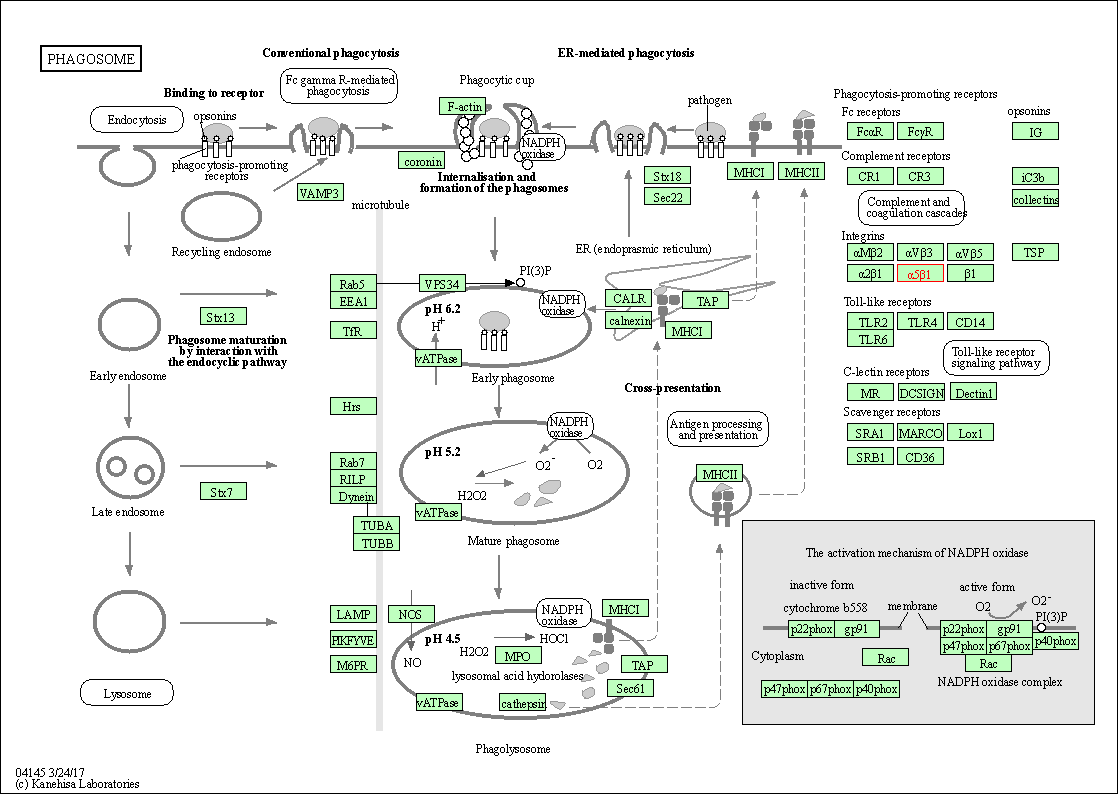
|
| Class: Cellular Processes => Transport and catabolism | Pathway Hierarchy | ||
| PI3K-Akt signaling pathway | hsa04151 | Affiliated Target |
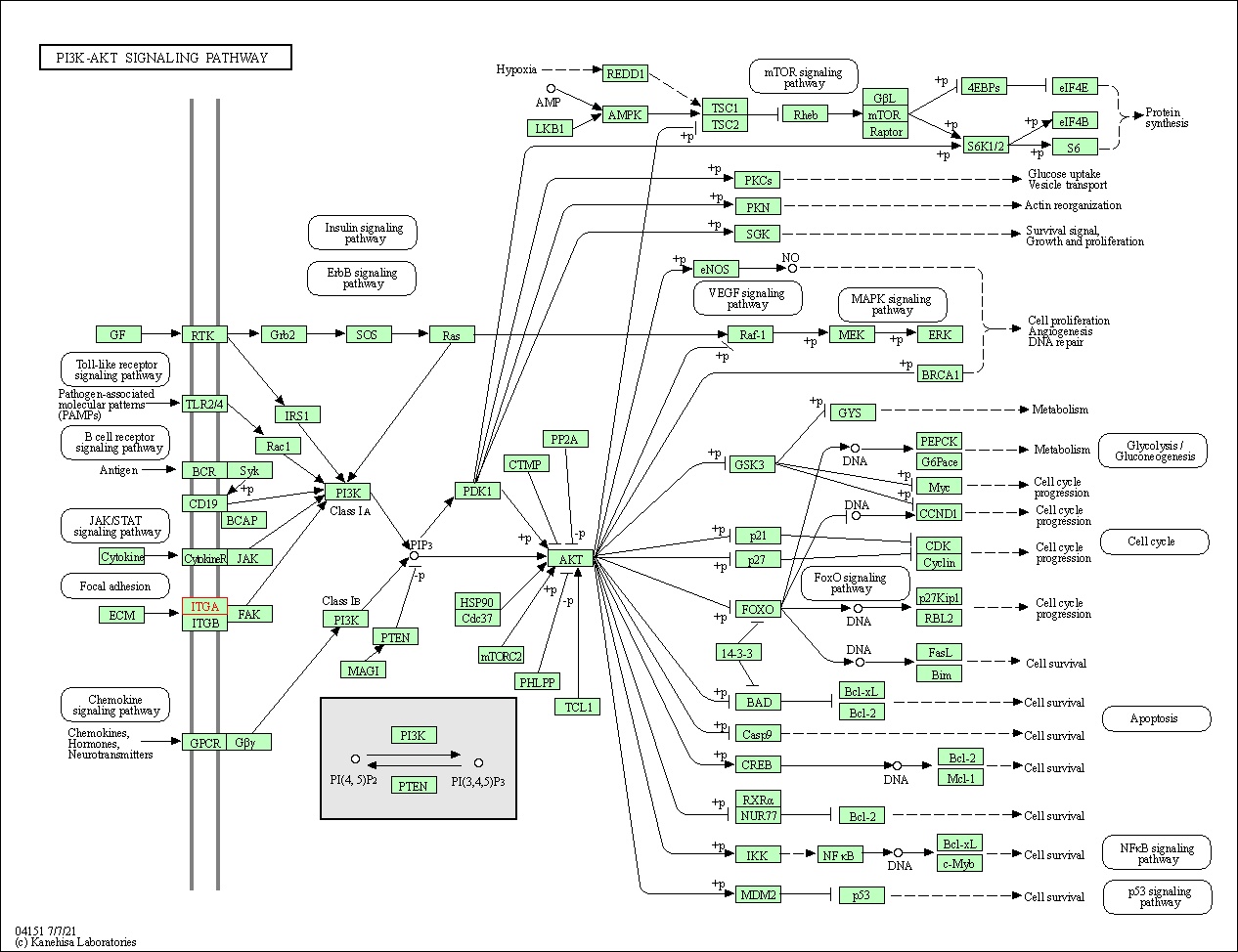
|
| Class: Environmental Information Processing => Signal transduction | Pathway Hierarchy | ||
| Focal adhesion | hsa04510 | Affiliated Target |
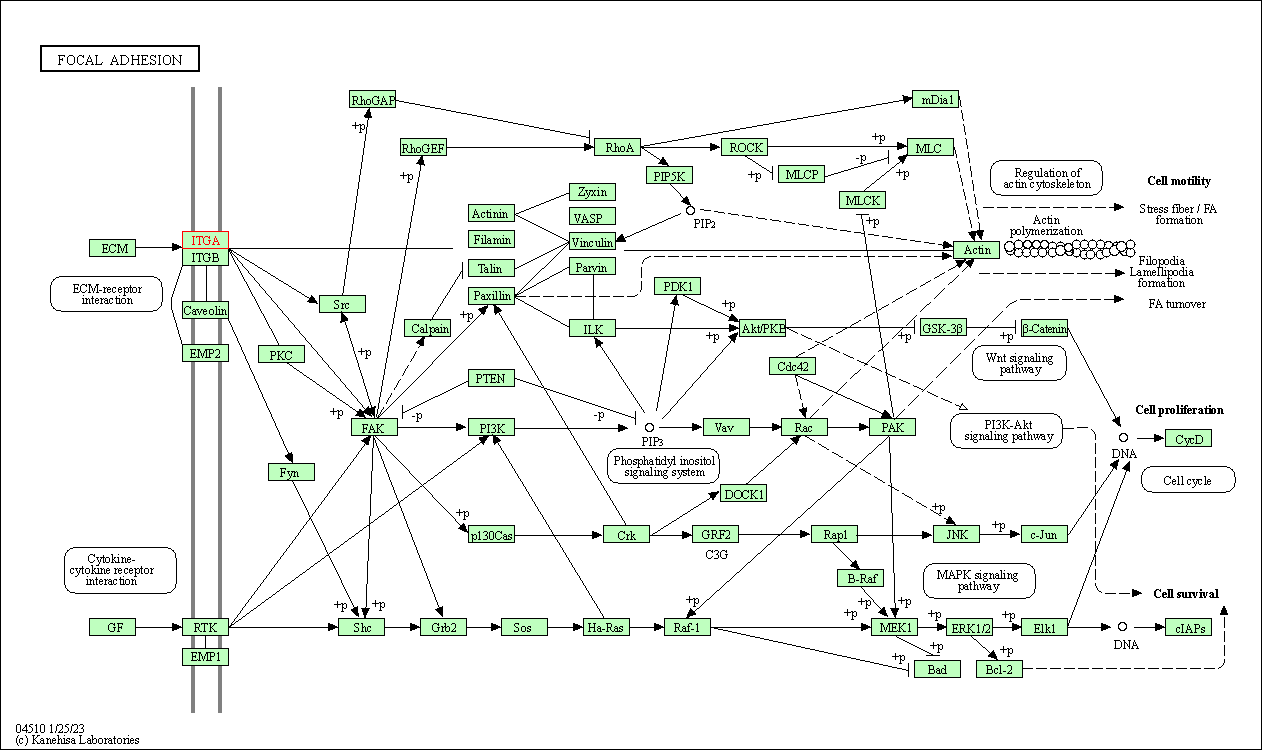
|
| Class: Cellular Processes => Cellular community - eukaryotes | Pathway Hierarchy | ||
| ECM-receptor interaction | hsa04512 | Affiliated Target |
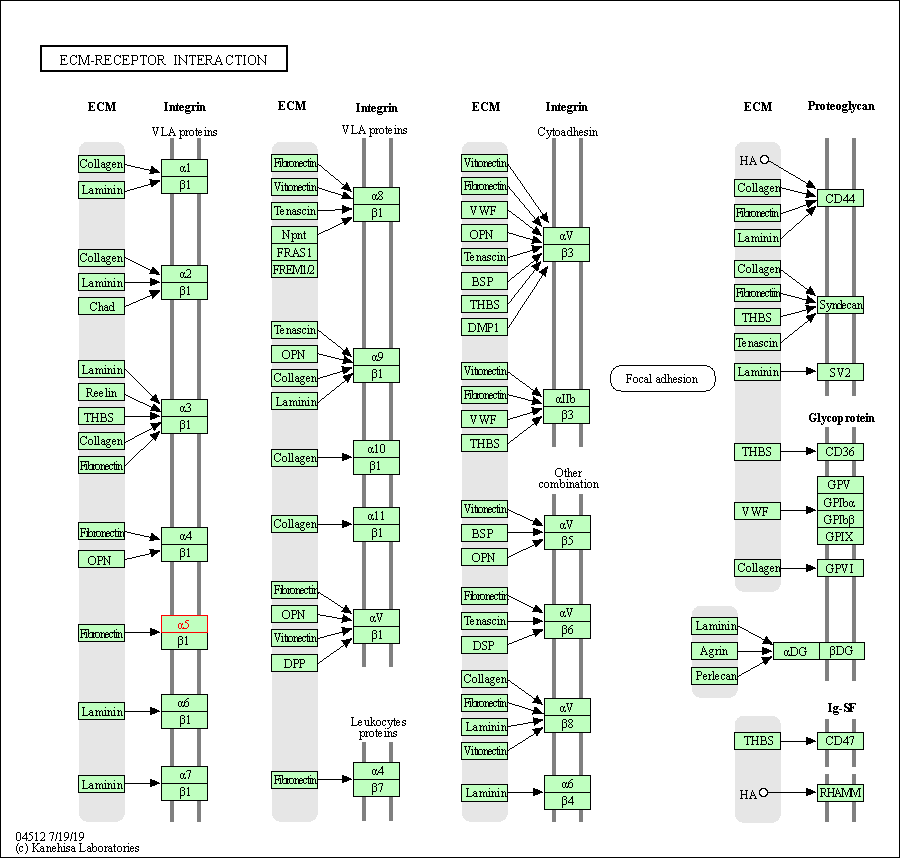
|
| Class: Environmental Information Processing => Signaling molecules and interaction | Pathway Hierarchy | ||
| Hematopoietic cell lineage | hsa04640 | Affiliated Target |
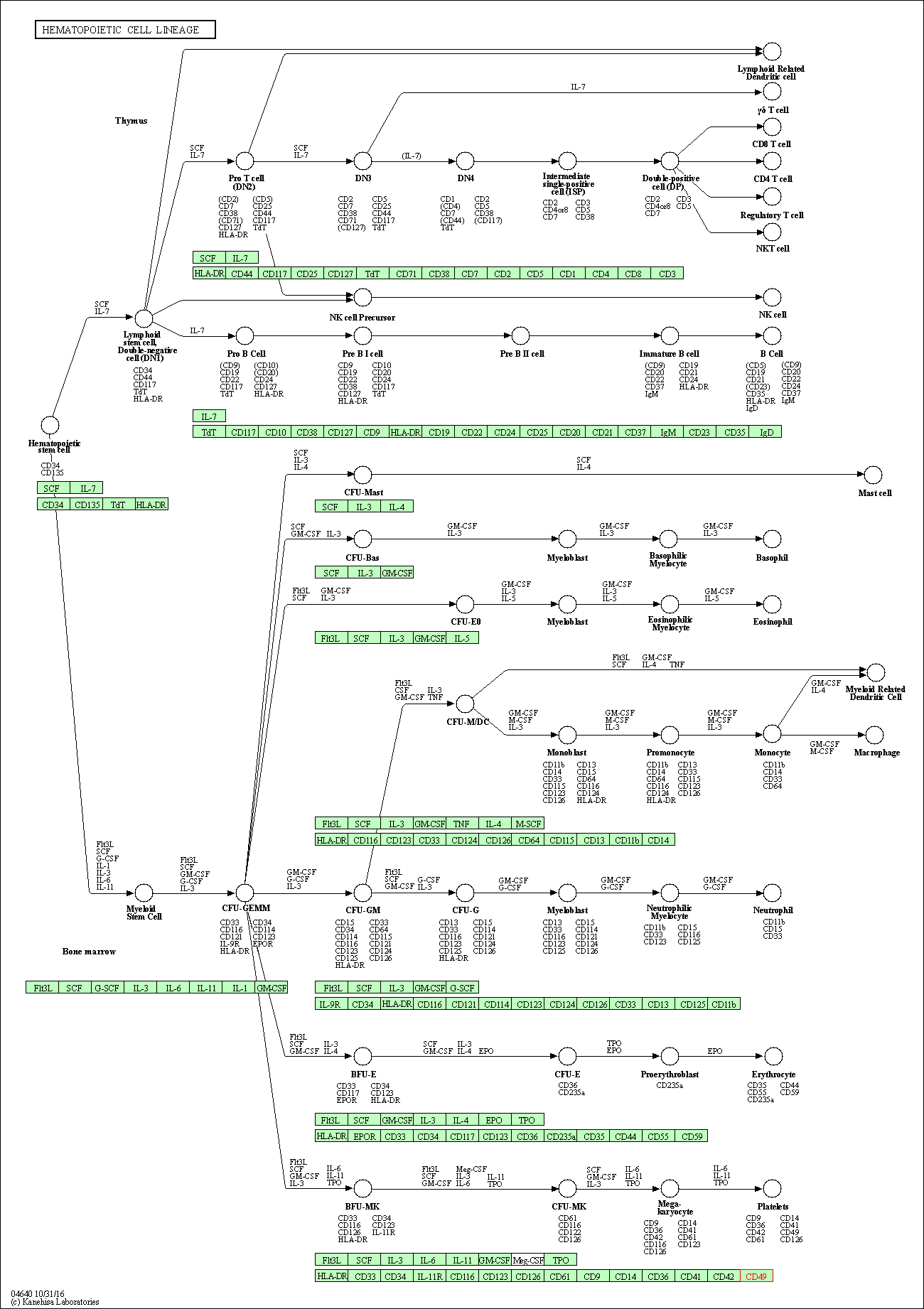
|
| Class: Organismal Systems => Immune system | Pathway Hierarchy | ||
| Regulation of actin cytoskeleton | hsa04810 | Affiliated Target |
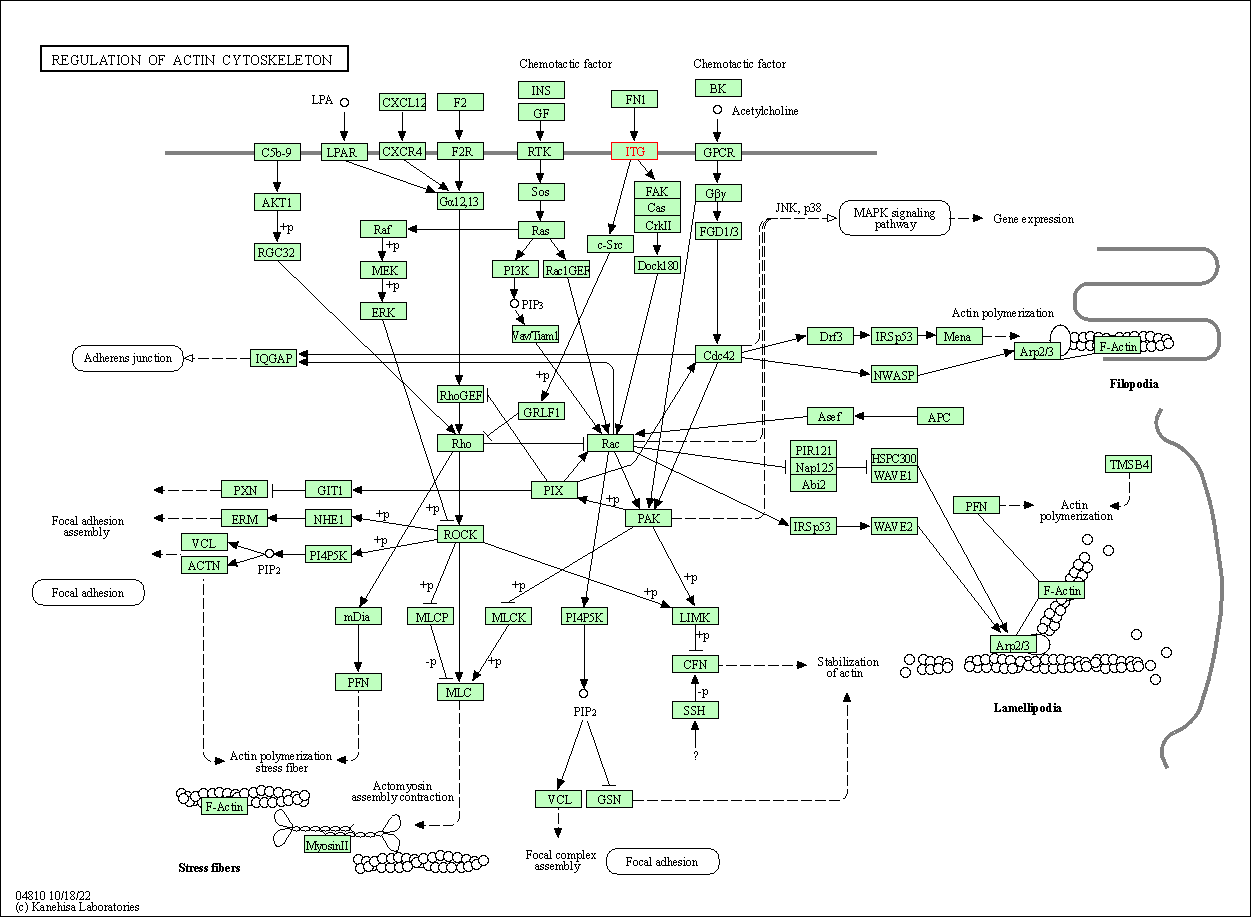
|
| Class: Cellular Processes => Cell motility | Pathway Hierarchy | ||
| Click to Show/Hide the Information of Affiliated Human Pathways | |||
| Degree | 14 | Degree centrality | 1.50E-03 | Betweenness centrality | 9.59E-05 |
|---|---|---|---|---|---|
| Closeness centrality | 2.25E-01 | Radiality | 1.39E+01 | Clustering coefficient | 1.98E-01 |
| Neighborhood connectivity | 3.01E+01 | Topological coefficient | 1.31E-01 | Eccentricity | 12 |
| Download | Click to Download the Full PPI Network of This Target | ||||
| Drug Property Profile of Target | Top | |
|---|---|---|
| (1) Molecular Weight (mw) based Drug Clustering | (2) Octanol/Water Partition Coefficient (xlogp) based Drug Clustering | |
|
|
||
| (3) Hydrogen Bond Donor Count (hbonddonor) based Drug Clustering | (4) Hydrogen Bond Acceptor Count (hbondacc) based Drug Clustering | |
|
|
||
| (5) Rotatable Bond Count (rotbonds) based Drug Clustering | (6) Topological Polar Surface Area (polararea) based Drug Clustering | |
|
|
||
| "RO5" indicates the cutoff set by lipinski's rule of five; "D123AB" colored in GREEN denotes the no violation of any cutoff in lipinski's rule of five; "D123AB" colored in PURPLE refers to the violation of only one cutoff in lipinski's rule of five; "D123AB" colored in BLACK represents the violation of more than one cutoffs in lipinski's rule of five | ||
| Target Regulators | Top | |||||
|---|---|---|---|---|---|---|
| Target-regulating microRNAs | ||||||
| Target-interacting Proteins | ||||||
| Target Profiles in Patients | Top | |||||
|---|---|---|---|---|---|---|
| Target Expression Profile (TEP) | ||||||
| Target-Related Models and Studies | Top | |||||
|---|---|---|---|---|---|---|
| Target Validation | ||||||
| References | Top | |||||
|---|---|---|---|---|---|---|
| REF 1 | An alpha5beta1 integrin inhibitor attenuates glioma growth. Mol Cell Neurosci. 2008 Dec;39(4):579-85. | |||||
| REF 2 | ClinicalTrials.gov (NCT00536016) A Phase 1 Safety Study of Single and Repeated Doses of JSM6427 (Intravitreal Injection) to Treat AMD. U.S. National Institutes of Health. | |||||
| REF 3 | Trusted, scientifically sound profiles of drug programs, clinical trials, safety reports, and company deals, written by scientists. Springer. 2015. Adis Insight (drug id 800016503) | |||||
| REF 4 | Trusted, scientifically sound profiles of drug programs, clinical trials, safety reports, and company deals, written by scientists. Springer. 2015. Adis Insight (drug id 800020029) | |||||
| REF 5 | Trusted, scientifically sound profiles of drug programs, clinical trials, safety reports, and company deals, written by scientists. Springer. 2015. Adis Insight (drug id 800012564) | |||||
| REF 6 | Trusted, scientifically sound profiles of drug programs, clinical trials, safety reports, and company deals, written by scientists. Springer. 2015. Adis Insight (drug id 800009742) | |||||
| REF 7 | Roles of integrin activation in eosinophil function and the eosinophilic inflammation of asthma. J Leukoc Biol. 2008 January; 83(1): 1-12. | |||||
| REF 8 | WO patent application no. 2008,1439,28, Methods and compositions for treating skin conditions. | |||||
| REF 9 | US patent application no. US2010278784 (A1), Methods and compositions for treating skin conditions. | |||||
| REF 10 | Eosinophil adhesion to cholinergic nerves via ICAM-1 and VCAM-1 and associated eosinophil degranulation. Am J Physiol Lung Cell Mol Physiol. 2002 Jun;282(6):L1279-88. | |||||
| REF 11 | Multiple N-methylation by a designed approach enhances receptor selectivity. J Med Chem. 2007 Nov 29;50(24):5878-81. | |||||
If You Find Any Error in Data or Bug in Web Service, Please Kindly Report It to Dr. Zhou and Dr. Zhang.

